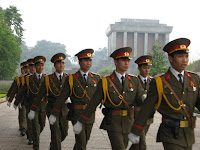So when I agreed to a three-day trek through Virachey National Park to write about the trip for my guidebook update in Travelfish, I wondered if I had signed up for a marathon session of the brief misery I had experienced months before. The leeches wouldn’t be as bad, I figured, since it’s only the beginning of rainy season. And I figured the payoff—seeing probably the most remote, unspoiled place I might ever visit in my lifetime and the views and wildlife that came with it—would be worth it. I was wrong.

We set out last Thursday morning with our guide, a former poacher-turned-park-ranger. We headed north, on motorbike, the 50-kilometer distance on winding, red clay roads, to the Sesan river where we’d boat into the jungle. The ride there was beautiful, passing steep hills, stilted villages, and endless cashew and rubber plantations. When we arrived at the river, I stood on the banks, looking out at nature. It was then that nature first attacked. Suddenly, I felt stinging pricks all over my body. I looked down and giant, red ants were crawling all over me. I’d chosen my lookout atop an ant hill. My guide and I rushed away, pulling frantically at our clothes and swatting the insects. It was an omen.

The two-hour boat ride, in a narrow, rickety, wooden boat that raised no more than a foot out of the water, was lovely. We arrived at our first destination in mid-afternoon. It was village of the minority Brou ethnicity that consisted of no more than six homes. One was a separate shed for homestay guests. We set up our beds—army-issue hammocks, and settled in for the day. The only thing to do was to watch the farm animals interact. I entertained myself picking out the alphas and watching them harass the smaller pigs and chickens. Males of all species are the same. Stephen attempted to interview some of the villagers for a story about illegal logging and poaching. We ate a hardy meal made from meat and vegetables packed in our guide’s backpack, I slipped myself a Dramamine to counteract the discomfort of sleeping with my feet pointing up and the nerves of the following day’s challenge.

The next morning, we headed into the park. After another, shorter boat ride, we left our boats behind and pulled on our leech socks—canvas boots that tie below the knee. Stephen’s had a big hole right at the ankle that our guide had failed to notice. He didn’t offer to swap, even after I suggested it. Apparently, $107 per person for the trip does not come with a guarantee of intact leech socks. My socks were twice the size of everyone else’s, fit for a burly male, although my ankles and calves are about the thickness of a seven-year-old boy’s.

“We came out of the jungle for a reason,” I thought, over and over again, as we walked, sloshing through ravines, climbing over dead trees, constantly pushing thick, wet tree branches aside. When I said it aloud to Stephen that night, he replied, “I’ve been waiting for you to say that.” After 10 months of living and working together every day, he knows my thoughts as well as I do.

The socks helped keep the leeches from getting to our flesh, but didn’t stop them from trying. Every few minutes, we’d stop and flick, stop and flick. Usually, they’d burrow between our socks and our shoes while we walked, waiting to climb upward when we stopped moving. We stopped for lunch beside a waterfall, removed leeches (one had wiggled inside Stephen’s shirt and stuck itself to the middle of his chest. The wound bled like a bullet to the heart). Then we swam in this far-away pool, in the middle of the jungle. It would be one of the only payoffs of the trip.

In the afternoon, we hiked uphill, over endless wet leaves and stagnant pools of water covered in black, slimy worms reaching upward toward our body heat. When I became tired, Stephen held my hand, half dragging me forward. Hours and 20 kilometers of walking later, we arrived at our camp beside another stream, where we bathed, de-leeched, ate, de-leeched, and slept again in a V. The tarps over our hammocks kept the night’s rain from coming inside, and I felt protected inside my bed, lifted above the hungry earth with a mosquito net shielding the malarial night jungle air. I thought of a baby, warm in its womb, and how it screams when forced to confront, for the first time, the bright, cold world. I heard rustling beneath me. Was it a sun bear? A tiger? I thought. No, our guide told us the next morning. Giant bamboo rats were foraging for food.

After another breakfast of instant noodles and vegetables, we headed out. More of the same—dense jungle, streams, wet leaves, and leeches. Like the day before, we spent part of the hike walking along the Ho Chi Minh trail, where, 30 years ago, Northern Vietnamese fighters transferred supplies and hid out from U.S. forces. The parallel lines where military truck tires once drove are still visible, though overgrown. Our guides pointed out rusted artillery and bombshells. I tried to appreciate it, but really, thought about the open sores on my feet from two days of walking in soaked sneakers stuffed with wet canvas.

We arrived at our final resting place, where we’d swim, eat, and board a boat back to civilization. I thought I’d feel a flood of relief, but it didn’t come. I just enjoyed taking off my shoes and washing in the cold, fast stream. We motored back. Our boat ran out of gas a few hundred yards from our destination, and we drifted slowly ashore. As we climbed off, I rushed past the red anthill, a savvier hiker by now, with only two toenails and a few ounces of blood missing.


















